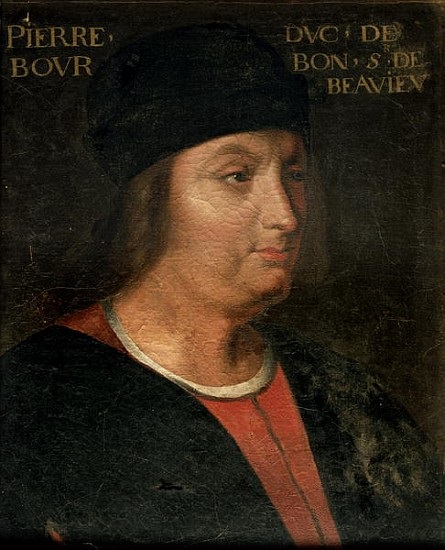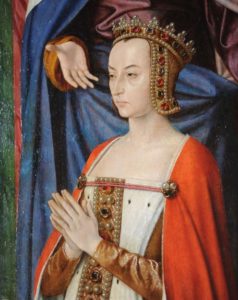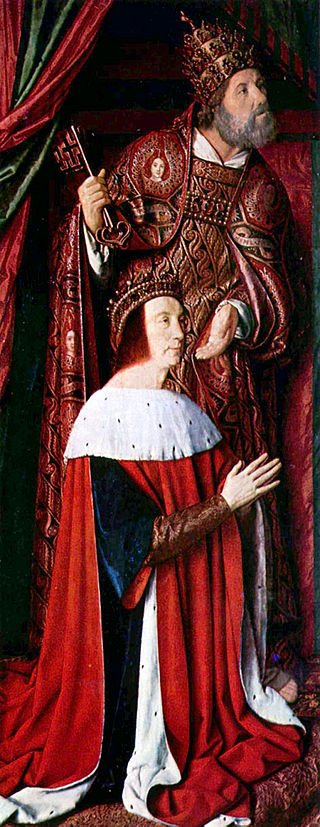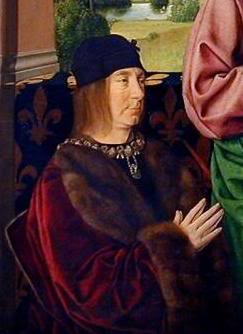Pierre II, Duke de Bourbon, breathed his last on the 10th of October 1503 in Moulins, France, at the age of 64 (he was born on the 1st of December 1438). He was the son of Charles I, Duke de Bourbon, and Agnes de Bourgogne. Although he was originally betrothed to Marie d’Orléans, sister of Louis, Duke d’Orléans (future King Louis XII), King Louis XI of France prevented this union from happening because he did not want an alliance of the Orléans family with the House of Bourbon. Therefore, Pierre ended up married to Princess Anne de France, Louis XI’s eldest surviving daughter – the wedding took place on the 3rd of November 1473.

Although Pierre was not Duke de Bourbon at first, Louis XII compelled Pierre’s elder brother – Jean II, Duke de Bourbon – to grant the Bourbon fief of Beaujeu (Beaujolais) to Pierre, who also received a place on the Royal Council. That is why history often remembers Pierre and his formidable wife, Anne de France, as Pierre and Anne de Beaujeu. Over time, Pierre earned the king’s great favor by making the Bourbon family as pliant as clay in his sovereign’s hands. At the time of Louis XI’s passing in 1483, Pierre was one of the few nobles who always remained in the monarch’s favor. Louis trusted to Pierre guardianship over his successor – King Charles VIII.

During the minority of Charles VIII, Anne and Pierre acted as co-regents for the young monarch. Anne and Pierre were skillfully creating a power-base of their own in the Bourbonnais, for Pierre became Duke de Bourbon when his brother, Jean, died without any surviving legitimate issue in 1488. Anne was already Countess de Gien, and Pierre was Count de Clermont and de La Marche, as well as Lord de Beaujeu. The inheritance of the title of Duke de Bourbon made them one of the most powerful families in France. Charles granted to them the domains of Bourbon-Lancy in 1488, and Pierre traded l’Isle-en-Jordain with the Armagnac family in 1489 for Carlades and Murat. The small realm of the family within the large French realm was considerable. The king also permitted them to bequeath their lands and wealth to whomsoever they wished.
Little is known about the marital life of Anne and Pierre. He was 23 years her senior, but it was normal for a woman back then to be married to a much older man. In some modern movies the producers introduced the idea that Anne was in love with her cousin, Louis d’Orléans (later Louis XII of France), who was forced by Louis XI to take Anne’s sister, the deformed Jeanne, as his wife. In none of historical documents related to the period, which I’ve ever seen, anything of the sort is implied or mentioned, and I personally don’t believe that it was true. Producers need drama to make their movies popular, and to accomplish this, they invent storylines appealing to a versatile audience. Perhaps there was no love between Anne and Pierre, but they acted as excellent partners as they ruled France during Charles VIII’s minority and their own vast lands.
The couple could have 2 children, although historical accounts about their possible son are contradictory. Presumably, Anne was pregnant in 1476, but she had a miscarriage. According to some sources, the couple had one living son – Charles styled as Count de Clermont, who supposedly passed away in 1498 and was buried in the Abbey of Souvigny, Auvergne. Anyway, the existence of this boy is doubtful, although it is unlikely that Anne was never pregnant between her wedding in 1473 and the birth of their daughter, Suzanne, on the 10th of May 1491. In any case, Suzanne de Bourbon remained their only heir if they really had a son, and although the girl was born sickly, both parents loved her and doted on her throughout her childhood.

Perhaps Anne had a series of miscarriages between these years. She was a representative of the senior Valois line that had become rather inbred by that time. Anne could have had some genetic problems that did not allow her to produce healthy progeny, for Pierre was a Bourbon and, hence, her cousin. Moreover, they were both descended not only from King Louis IX of France known as Saint Louis, but also from King Jean II of France called the Good (le Bon). Pierre’s mother – Agnes de Bourgogne – was the daughter of Jean the Fearless and Margaret of Bavaria, while Jean was a grandson of Jean II. So, Anne and Pierre were 3rd cousins, which seems to be not a very close relationship, if not for the fact that their bloodlines had also intersected several times in the past. This might explain the reproductive problems of the couple if they had them, for we do not know this; maybe they rarely shared a bed because of their loveless marriage.
This regency lasted from 1483 until 1491, with many difficulties. Their troublesome cousin, Louis d’Orléans, believed that the regency should have been his in the light of the ancient law that the nearest male relative inherited the throne and became regent for a king who did not reach his age of majority. Moreover, Louis XI had subdued all rebellious lords to centralize the country, having some of their lands confiscated. During the regency, these nobles demanded their estates and titles back, joining Louis d’Orléans and forming the Orléans party. Their disagreements led to an open military conflict – it was the so-called ‘Mad War,’ which ended only in 1488. Anne and Pierre were forced to make many concessions to their opponents, returning many of the confiscated lands to these lords, but Louis d’Orléans failed to win the regency.
By 1491, Charles VIII was already 21, so he cancelled the regency and started his own reign. Against the advice of Pierre and Anne, the king renounced his obligations to marry Margaret of Austria, who had spent a lot of time in France in her childhood as a bride for the future monarch. Charles returned her dowry – Artois and Franche-Comté – to her father, Philip the Handsome, and send the girl back to Flanders, which caused Margaret’s antipathy towards everything French for the rest of her life. Nonetheless, thanks to the efforts of Anne and Pierre, the kingdom of France did not find itself in the complete encirclement of the huge Habsburg domains as they secured for Anne’s brother a beneficial match – Anne de Bretagne, whom the monarch married.
Anne and Pierre failed to preclude Charles VIII from undertaking his expedition to Italy, which turned out to be disastrous. After Charles’ death and the ascension of King Louis XII, Anne and Pierre both returned to their estates. They made a deal with Louis XII that their only daughter, Susanne, would inherit the Duchy of Bourbon despite being a woman. Anne and Pierre devoted all their time to Suzanne. The next heir to the duchy was Louis, Count de Bourbon-Montpensier, but Pierre decided to have Suzanne betrothed to Charles IV, Duke d’Alençon, who was a favorite of King Louis XII, and the contract was signed in 1501. Yet, as Pierre contracted a severe fever and died, and as Louis de Bourbon-Montpensier also passed away in the same year, later Anne had Suzanne betrothed to the next heir the Duchy of Bourbon – Charles, Count de Bourbon-Montpensier and lords of other lands, who would later be known as the treacherous Constable de Bourbon and would betray King François by conspiring with Emperor Charles V.
All images are in the public domain.
Text © 2020 Olivia Longueville





